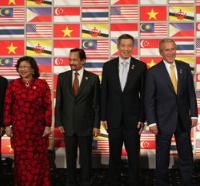PHNOM PENH, Cambodia -- In search of raw materials, China has increasingly used development assistance to court Cambodia, Laos, and Vietnam, three countries "forgotten" since the Vietnam War. The U.S., too, has stepped up its activities in the region since the Sept. 11 attacks, although its efforts have focused more on counterterrorism cooperation than on directly addressing the growing Chinese influence. But as Southeast Asia increasingly becomes the object of the two powers' attention, some in the region are expressing discomfort with their growing rivalry. A January 2008 report (.pdf) by the Congressional Research Service (CRS) noted that China outpaced the U.S. in assistance to lesser developed Southeast Asian countries last year. Cambodia, for example, received $689 million from China in 2007, along with pledges of $1 billion in loans in 2008 for two dam projects to power the electricity-starved countryside. That's far above the U.S.'s total assistance of $55 million in 2007, mostly disbursed through non-governmental organizations (NGOs). The effect of China's no-strings-attached approach to development aid is noticeable. Throughout the 1990s, when aid was more clearly dominated by Western donors and Japan, Cambodian Prime Minister Hun Sen worked through multilateral aid agencies and the United Nations. Now, he publicly blasts such organizations, threatening to close the offices of the UN human rights agency after taking offense at comments made by its recently resigned representative, Yash Ghai, and banning the NGO Global Witness in 2007 for publishing a report critical of his family's involvement in illegal logging. Currently facing a $1 billion shortfall in development funds from a lagging economy, Sen met with Chinese Premier Wen Jiabao on Oct. 24 at the Asia-Europe summit and was promised $280 million in loans for infrastructure.
Chinese Aid Wins Hearts, Twists Arms in Southeast Asia

